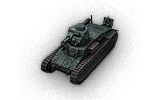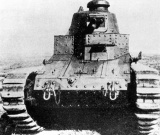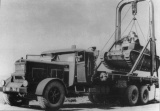D1
| Revision as of 18:39, 4 May 2012 | Revision as of 04:52, 5 May 2012 | |||
| Line 18: | Line 18: | |||
| Pros: | Pros: | |||
| ? | * Above average | + | * Above average hit points | |
| ? | * Above average turret armour | + | * Above average hull and turret armour | |
| + | * Above average damage and penetration | |||
| + | * Above average aim time and elevation arc | |||
| Cons: | Cons: | |||
| ? | * Below average engine power | + | * Below average engine power, top speed, and traverse speed | |
| ? | * Below average | + | * Below average rate of fire | |
| ? | * Below average traverse speed | + | * Below average accuracy and turret traverse speed | |
| + | * Below average ammo capacity | |||
| + | * Below average view and signal range | |||
| Line 39: | Line 43: | |||
| ? | {{EquipmentPanel||Suggested Equipment}} | + | {{EquipmentPanel|Improved Ventilation Class 1, Enhanced Gun Laying Drive, Small Spall Liner, "Wet" Ammo Rack Class 1, Camouflage Net|Suggested Equipment}} | |
| }} | }} | |||
| {{Panel Gallery|Gallery| | {{Panel Gallery|Gallery| | |||
Revision as of 04:52, 5 May 2012
| |
This article requires additional modification. The design and/or content of this article do not conform to wiki standards. |

The D1 is a French tier 2 light tank. It has better armor than the RenaultFT while maintaining similar mobility. It's guns are capable of more damage, but penetration remains poor, particularly against tier 3 opponents. Physically, it's much larger than the RenaultFT.
- The D1 leads to the D2.
D1/ModulesD1/EquipmentD1/Consumables
Pros and Cons
Pros:
- Above average hit points
- Above average hull and turret armour
- Above average damage and penetration
- Above average aim time and elevation arc
Cons:
- Below average engine power, top speed, and traverse speed
- Below average rate of fire
- Below average accuracy and turret traverse speed
- Below average ammo capacity
- Below average view and signal range
Combat Effectiveness
Early Research
Suggested Equipment
Historical Info
As the ST1 turret type had been rejected, a new one had to be developed. Until it was ready all 160 Char D vehicles were temporarily fitted with existing Renault FT turrets, taken from the Renault FT matériel reserve. Two new turret designs were proposed by Schneider. The ST3 was a modification of the ST1. To solve the balance problem, this type had an armoured extension at the back, with a large square opening. The hatch in the back of the main armour could be opened through the square hole of the extension, providing more room for the commander, who, when operating the gun, would still enjoy some protection against small arms fire, without the weight penalty of a larger turret. The matériel commission judged this system, though ingenious, to be hugely impractical — it made the turret more vulnerable in precisely those situations where it was most likely to be hit: when fighting the enemy — and decided to accept the weight penalty, choosing the alternative ST2 that was simply a larger turret that had more room at the back, weighing three metric tonnes. Nevertheless a single pre-series vehicle was fitted with the ST3 for trials and afterwards used in this configuration by the driver school.
This ST2 turret had a very complex geometry with many shot traps. This was partly caused by the large protruding diascopes at the sides, but also a result of forcing the commander to operate in three height levels: he had to stretch himself to observe his surroundings via the cupola, had a forward observation hatch that he could look through while standing in a normal position and had to crouch to operate the 47 mm SA34 gun to the right of him and the coaxial 7.5 mm machine gun to the left. The lower level had its own extension, where extra room had been found in the front of the turret to bring the machine gun forward, while retracting the main gun, thus improving balance even further. Needless to say, the army was very critical of this general arrangement, but it could not be rejected as deliveries were already greatly delayed: the first replacement turrets were fitted only in early 1936.
The ST2, weighing 1788 kg, brought the total weight to fourteen metric tons and, costing 100,000 FF per piece, the total vehicle price to 475,000 FF. The Char D1 was thus neither particularly light nor cheap, causing the Hotchkiss company to propose a design better conforming to the role of mass produced light infantry tank, which proposal would eventually result in no less than three production types: the Hotchkiss H35, Renault R35 and FCM 36. However, even in 1926 the project had been seen as more of a cheaper alternative to the Char B than as a pure light infantry tank; the political situation of the early thirties would force the Char D1 completely into the role of Char de Bataille or "battle tank".







